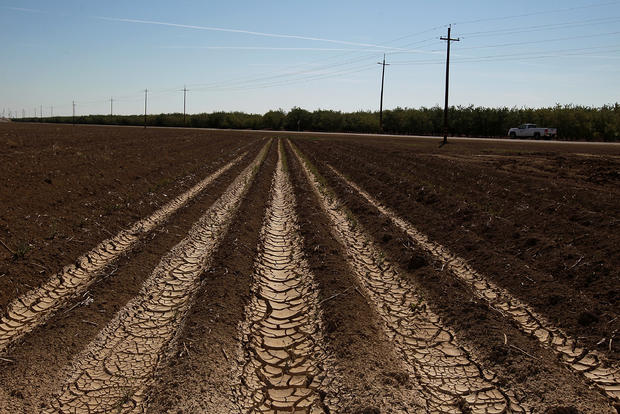NASA's SMAP Observatory To Improve Drought Prediction, Planning For Natural Disasters
Matt Kamlet, CBS Los Angeles
LOMPOC, CALIF. (CBSLA.com) — Minutes before the sun dawned on the coast of central California on Saturday, NASA looked to the skies, and launched a critical part of its Earth Sciences mission into Low-Earth Orbit.
As floods make their way through parts of the country, and as a historic drought continues to punish the farmlands, rivers, and resources of California, scientists will now be able to more accurately observe and monitor moisture levels within the land itself, through an orbiting observatory named SMAP (Soil Moisture Active Passive).
Similar to the OCO-2 observatory, which launched from the same launch pad back in July of 2014, and which now monitors carbon cycles around the globe, SMAP's mission is to better understand water cycles between the land and atmosphere.
"We're looking across the whole United States," SMAP Program Scientist Jared Entin told social media users invited by NASA. "We're looking across all of North America, all over the world, trying to look at these soil moisture patterns and see how they effect weather regimes, ultimately climate, and we're really looking at the big picture."
SMAP marks the fifth satellite launched by NASA since February 2014 with the goal of monitoring our planet's reaction and response to changes, both natural and human-induced.
The advantages of this knowledge are as vast as they are essential.
In addition to more accurate weather forecasts, meteorologists and other scientists will have the ability to better predict natural hazards, such as floods, hurricanes, wildfires and drought.
As the agricultural community of California found out over the past year and a half, if the state found itself in a position to be able to plan more accurately ahead of time for such an event, a great amount of money and grief may be saved.
"...SMAP is not going to create water magically to solve all the problems; I wish it could, it wont," Entin said. "But, it is going to give people more information. For those of us who came from the East coast, you saw that two days before the blizzard, people knew, and they were able to prepare. And with SMAP and other observations, we're trying to give the farmers as much information as we can about what's coming now, what can you plan for."
The initiative of studying soil moisture is not exclusive to the minds of NASA scientists, but to researchers from the National Oceanic Atmospheric Administration (NOAA) and the U.S. Department of Agriculture.
USDA research scientist Dr. Wade Crow says that, even in years in which agricultural production increases, evidence exists that suggests that we are becoming more susceptible to the impacts of droughts and other agricultural shocks.
An example of this evidence is the 2008 food shortage crisis, in which the price of food doubled globally, due in part to the influence of agricultural drought. Current trends have sparked fears, beyond the agricultural community, that the next large drought may cause a similar, or worse, social, economic and political crisis.
Soil moisture research may help defend against such a repeat.
"Soil moisture is the most direct and the earliest indication of agricultural drought," Dr. Crow said. "An agricultural drought, by definition, is a lack soil water resources, so you don't have enough water in the soil for agricultural crops, to produce fruit, to produce grain. So it's the most direct, the most valued variable associated and identified with agricultural drought."
"Secondly, it's also the earliest. By the time you see agricultural drought manifest itself in vegetation health, it's often too late. So the first indication we'll get of a drought is a low soil moisture anomaly in the soil."
SMAP represents the most efficient and technologically advanced tool in observing soil moisture. This is due to its accuracy, global observation, resolution and repeat time. The idea, essentially, is to use this data not to prevent these occurrences from taking place, but to decrease the impact felt, both economically and from a humanitarian standpoint, when they do happen.
USDA agencies are integrating SMAP's data into their agricultural forecasting systems. In total, there are over 40 organizations, agencies, and universities using SMAP's data for research in agriculture, weather, emergency response, human health and military readiness.
The launch of the spacecraft itself took place at approximately 6:20 a.m. on Saturday, January 31, from Space Launch Complex Two (SLC-2) at Vandenberg Air Force Base, two hours north of Los Angeles, with the assistance of the U.S. Air Force's 30th Space Wing. The observatory launched atop a United Launch Alliance Delta II 7320 rocket, after originally being set for launch at 6:20 a.m. on Thursday.
High wind shears were responsible for scrubbing the launch on Thursday, exceeding speeds considered to be within the threshold of a safe launch of the Delta II. NASA and ULA, considering public safety as precedent, reset the launch for Friday. However, that launch was delayed in order to give crews an opportunity to make minor repairs to the launch vehicle.
The launch was reported seen as far south as Huntington Beach.
Ultimately, NASA tackles challenges in addition to space exploration and aviation — the responsibility and initiative of knowing more about our own planet, and how to better care for it. On Wednesday, NASA Administrator Charles Bolden touched on this responsibility, and the importance of what NASA is doing through its Earth Science objectives.
"The big thing we're trying to do is understand the planet," Bolden told social media users next to SLC-2 during tower rollback. "We know that things are happening, many of which are not good. So a large portion of what we're doing in Earth Science is trying to help us understand the cycles that are going on, try to help understand how much humans are contributing to the things that we're seeing, so that we can take action."
In a way, the SMAP mission is the very embodiment of what NASA is trying to do for our planet — achieve an understanding of our home that will help us make decisions to take better care of her, through the use of science, initiative, ambition, and ultimately, action.
For more on how organizations and agencies are using SMAP's data, visit NASA JPL here.
RELATED STORIES:
NASA's Innovative Ground Collision Avoidance System Could Save Hundreds Every Year
NASA Launches Revolutionary OCO-2 Satellite For Climate Study, Avenges 2009 Setback





